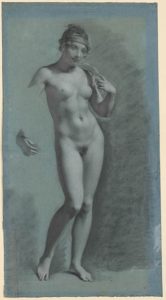Artistic geniuses often come in opposing pairs. Think of Delacroix and Ingres, Picasso and Matisse, Tolstoy and Dostoevsky, Dickens and Trollope. They are not always true opposites, but their contrasting temperaments, and often their opinions of each other, can define them more dramatically in our minds.

“Andromache and Astyanax.”
Trollope, the great realist, detested Dickens for his cartoonish characters and his reliance on coincidence. Picasso, the undisputed master of line and form, was no match for Matisse when it came to color and flat design. Tolstoy viewed his characters like an omniscient god, while Dostoevsky made us identify with his tormented madmen.
And so it was during late 18th and early 19th century France with Pierre-Paul Prud’hon and Jacques-Louis David. David was the father of neo-classicism, a painter of heroic themes from antiquity – Greek soldiers falling on their swords, Socrates taking the hemlock. His art celebrated virtue, strength, and courage. Prud’hon was the opposite. He painted romantic allegories in which idealized figures represented love, innocence, and pleasure. His was a poetic, dreamy world of soft caresses and languid embraces.
It was never an even contest. David dominated French art under the reign of Napoleon, whose values his art epitomized. Prud’hon, in contrast, occupied an off-center position, not without honor and commissions, but often thought of as a genre artist.
His reputation waxed and waned during his life, and has continued to do so since his death in 1823. As romanticism gained ascendance in the 19th century, his art began to seem more prophetic. And yet, Prud’hon was never a pure romantic. His art had many of the hallmarks of neo-classicism – his idealization of the human form was Greek in origin, and his mythical themes – such as Venus and Adonis – were clearly classical.
The retrospective of his work now at the Metropolitan Museum is the first ever in America, and will be many people’s first exposure to the full range of his work. Nowadays, with romanticism and classicism no longer the main poles of art, Prud’hon can be seen as an idiosyncratic artist who took what he wanted from the cross-currents of his time and invented a pictorial world all his own.

It is a show, above all, for people who love drawing, for Prud’hon was one of the great draftsmen of all time, with a style of drawing that was the opposite of David’s. Whereas David encircled his forms with a strong contour line, emphasizing the silhouette, Prud’hon built up his forms from the inside out, with subtle gradations of light and shadow that make us aware that the human body has no true edges.
He often drew on a bluish paper, in which the blue functions as a middle tone, the highlights are rendered in white chalk, and the shadows in black chalk. This technique, along with his skillful modeling, make his figures seem to magically emerge from the surface of the paper.
In contrast to David’s virile style, Prud’hon’s style is sometimes referred to as feminine. He often suppressed the hard angularity of the male body, pushing his male figures toward androgyny. In his painting “The Union of Love and Friendship,” Love is represented as an adolescent Cupid with a delicate female face, a sinuously curved body, and a jutting hip.
So languid do his bodies become that they sometimes seem to contain pliable bones. In “Justice and Divine Vengeance Pursuing Crime,” the figure of the wounded victim lies sprawled in the foreground, his body describing a graceful but near-impossible arc.
Prud’hon was by no means neglected by Napoleon’s imperial court. He had numerous portrait commissions, including several from Empress Josephine. One, a pensive and slightly melancholic pose, was done after she was divorced from Napoleon.
Prud’hon’s life was a productive one, but he endured numerous personal hardships, and his letters, often sad and complaining, seem appropriate to the 19th century image of the suffering romantic. He had money problems and marriage problems. For a time, he forged a happy relationship with a former student, Constance Mayer, with whom he collaborated on many paintings. However, she committed suicide in a fit of despondency in 1821. Prud’hon never seemed to recover and died two years later.
Prud’hon was perhaps a better draftsman than he was a painter, perhaps because he thought in terms of dark and light, rather than color, and because the graininess of chalk on paper suited his technique of building form out of soft gradations. Also, in the more vivid and highly worked paintings, his romantic vision can become somewhat cloying. But, no matter. The drawings are so good that it wouldn’t matter if Prud’hon had never painted a single stroke.

